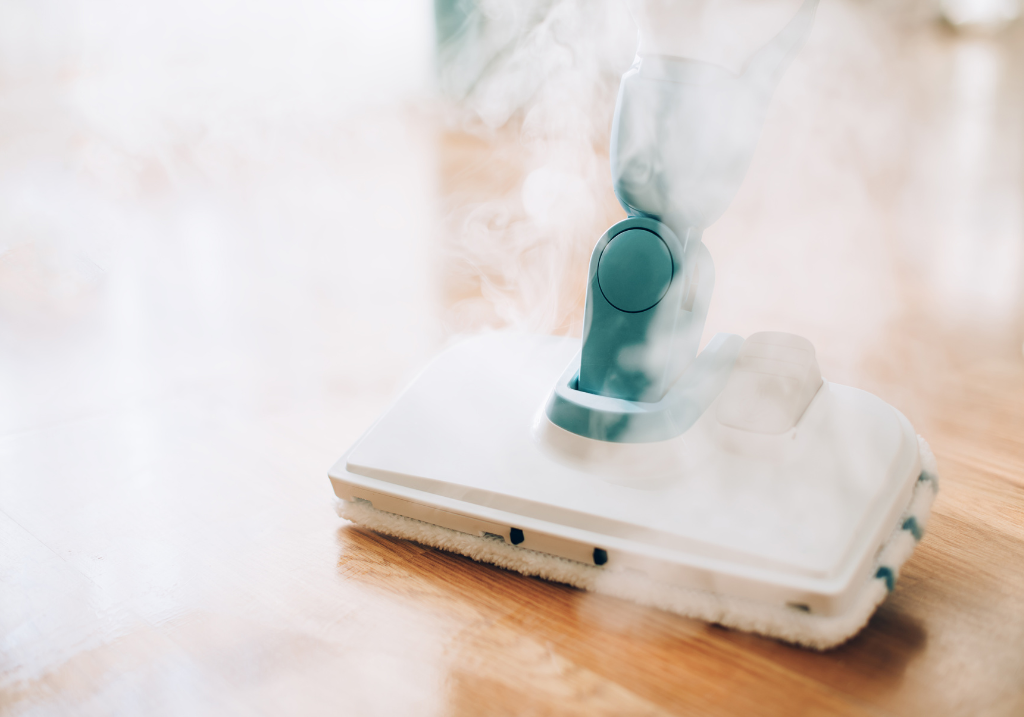Navigating the world of tile maintenance can seem daunting, especially with various cleaning tools like steam mops available.
At Ceramic City, Ireland’s premier supplier of ceramic and porcelain tiles, we’re here to provide you with all the information you need to make the best choices for your home.
This detailed blog we will explore whether or not you can you use a steam mop on porcelain tiles.
And in short:
Absolutely, without a doubt, the answer is a resounding yes.
Steam mops and porcelain floor tiles are a perfect combination.
Using steam to clean your tiles not only removes grime, but also sterilises the surface, making it perfect for households with active children or pets.
But that’s not the full story.
Keep reading to find out more.

Understanding Porcelain Tiles
What Makes Porcelain Tiles Unique?
Porcelain tiles are a staple in modern Irish homes due to their robustness and visual appeal.
Made from finely ground sand, these tiles are fired at temperatures so high that they become dense and vitrified, turning them into a material with a water absorption rate of less than 0.5 percent.
This makes porcelain tiles virtually waterproof, an ideal choice for kitchens and bathrooms.
The Benefits of Steam Mopping Porcelain Tiles
Hygiene and Safety
One of the standout benefits of using a steam mop on porcelain tiles is the superior level of hygiene and safety it offers.
Steam cleaning uses high-temperature steam to effectively sanitize surfaces, killing up to 99.9% of common household germs and bacteria without the need for chemical detergents.
This feature is particularly advantageous for homes with young children, pets, or anyone with allergies, as it minimizes exposure to harsh cleaning agents that can trigger allergic reactions or skin irritations.
Moreover, steam mops contribute to a healthier indoor environment by reducing the volume of chemicals that linger in the air and settle on surfaces within your home.
Traditional cleaning products often leave behind residues that can adversely affect indoor air quality and may pose long-term health risks.
By using steam, not only are you ensuring a thorough clean, but you’re also supporting a more sustainable and environmentally friendly cleaning practice, reducing the ecological footprint of your household.

Efficiency and Effectiveness
Steam mops excel in their ability to deliver a deep and efficient cleaning experience.
The high-pressure steam penetrates the microscopic pores and textures of porcelain tiles, dislodging dirt, grime, and even microscopic pathogens that traditional mops or manual scrubbing might miss.
This capability is especially beneficial for textured or embossed tiles, where dirt can easily accumulate in the crevices and is harder to remove with standard mops.
Scuff marks on porcelain tiles might need more work, however.
The steam’s heat also has a unique advantage in that it evaporates quickly, leaving your tiles dry soon after cleaning.
This not only speeds up the cleaning process but also prevents the formation of water spots and streaks, which are common issues when using traditional mopping methods.
Additionally, steam mopping does not require repetitive rinsing or the use of bucket loads of water, which helps in preserving the integrity of grout lines by preventing excessive moisture that can lead to mold and mildew growth.
By choosing a steam mop for your porcelain tiles, you’re not only opting for a method that is effective in cleaning but also preserving the beauty and longevity of your tile flooring.
The steam ensures that tiles continue to look new, maintaining their sheen and color over time, unlike harsher cleaning methods that can dull the tiles’ finish.
Proper Techniques for Using a Steam Mop om Porcelain Tiles
Properly using a steam mop not only ensures effective cleaning but also extends the life of your porcelain tiles.
Before you read on, you might benefit from knowing if porcelain tiles are slippy when wet.
Here’s a detailed guide, complete with helpful tips, to maximize the benefits of your steam mop:

Step-by-Step Guide to Effective Steam Mopping
- Preparation:
- Clear the Area: Ensure the floor is free of furniture and other obstacles that could hinder effective mopping.
- Sweep or hoover: Thoroughly sweep or hoover the area to remove any loose debris, dust, or pet hair. This prevents scratching the tile surface during steam mopping.
- Mopping:
- Fill and Heat: Fill the steam mop’s reservoir with clean water and allow it to heat up to the recommended temperature. This usually takes a few minutes.
- Mopping Technique: Glide the mop over the tiles without pressing down too hard. Overlap your strokes to ensure no spots are missed and that the steam has enough time to act on the surface dirt.
- Aftercare:
- Immediate Drying: After mopping, quickly pass over the area with a dry microfiber cloth or mop pad to pick up any residual moisture. This helps prevent water spots and streaks on your tiles.
- Ventilation: Open windows or use fans to aid in drying and air circulation, further reducing potential moisture buildup.
Tips to Maximise Your Steam Mopping
- Water Quality:
- Use Distilled Water: To prevent scale build-up in your steam mop, use distilled or demineralized water. This is particularly important in areas with hard water, which can leave deposits inside your mop over time.
- Mop Maintenance:
- Change Cleaning Pads Regularly: Use a clean pad at the start of each session to ensure efficient cleaning. Wash pads between uses to maintain their effectiveness.
- Inspect and Clean the Mop: Regularly check the steam mop for any clogs or debris that might be blocking the steam outlets. Follow the manufacturer’s instructions for cleaning the mop head and nozzle.
- Optimal Steam Settings:
- Adjust Steam Levels: Depending on the dirt level and the type of porcelain tile, adjust the steam level accordingly. Higher steam settings are best for deep cleaning, while lower settings are suitable for quick, light cleans.
- Pre-Treat Stains: For tough stains, pre-treat the area with a suitable cleaning solution before steam mopping to enhance cleaning efficiency.
- Safety Precautions:
- Handle with Care: Always handle the steam mop with care, as the steam can be extremely hot and may cause burns if misdirected.
- Immediate Care for Spills: If there are any liquid spills on the floor, attend to them immediately with the steam mop to prevent the spill from setting into the tiles.
Best Practices and Common Mistakes in Tile Maintenance
Maintaining porcelain tiles involves more than just regular cleaning; it requires knowledge of what not to do and why certain traditional methods might not be the best choice.
Here’s an expanded look at common mistakes, a comparative analysis of steam mops versus traditional mops, and advanced maintenance tips to keep your tiles in pristine condition.
If you’re looking for tips to clean your bathroom tiles, we’ve got you covered.

Common Mistakes in Tile Maintenance
- Using Abrasive Scrubbers or Steel Wool:
- Surface Damage: Abrasive materials can create scratches and scuffs on the surface of porcelain tiles, which are not only unsightly but can also become dirt traps.
- Avoid Harsh Scrubbing: Instead of using harsh scrubbing tools, opt for soft, non-abrasive cloths or mops that can clean effectively without damaging the tile’s glaze.
- Applying Bleach or Ammonia-Based Cleaners:
- Grout Damage: These harsh chemicals can erode grout, leading to its deterioration over time.
- Chemical Discoloration: They can also cause discoloration and fading of the tile surface, especially on colored or patterned tiles.
- Safer Alternatives: Use pH-neutral cleaners designed for tile cleaning, which are gentle on both the tiles and the grout.
Comparative Analysis: Steam Mops vs. Traditional Methods
- Residue Issues with Traditional Mops:
- Traditional mopping often leaves a residue of soapy water, which can attract more dirt and degrade the cleanliness of the floor over time.
- Quick Drying: Steam mops use heat and vapor to lift dirt and grime, leaving behind almost no residue and allowing the floor to dry much quicker.
- Sanitization Effectiveness:
- Limited Germ Removal: Traditional mops are less effective in removing germs and bacteria unless used with disinfectants, which can be harsh on the surfaces and indoor air quality.
- Natural Sanitization: Steam mops achieve high levels of sanitization naturally, using just heat and water to kill off common pathogens.
- Ease of Use and Efficiency:
- Physical Effort: Traditional mops require more physical effort – wringing out, heavier mops, and frequent water changes.
- Streamlined Cleaning: Steam mops provide a more effortless experience with continuous steam production, lightweight design, and no need for frequent water refilling.

Advanced Maintenance Tips for Porcelain Tiles
- Regular Sealing of Grout Lines:
- Protection Against Moisture: Sealing the grout helps prevent water and moisture penetration, which can lead to mold growth and structural damage.
- Frequency: Depending on the area’s usage, grout should ideally be sealed once a year to maintain its integrity and appearance.
Here’s a blog to show you how to clean grout lines on your tiles.
- Polishing Glossy Finished Tiles:
- Enhancing Shine: Use a clean, dry microfiber cloth to buff and polish glossy tiles after cleaning. This not only enhances their shine but also helps to remove any residual streaks.
- Avoid Wax-Based Polish: Ensure that any polishing products are suitable for use on porcelain tiles and do not contain waxes or oils that can create a slippery surface.
- Preventative Measures for Tile Care:
- Furniture Pads: Attach felt pads to the legs of furniture to prevent scratches and scuffs on tile floors when items are moved.
- Immediate Spill Responses: Clean spills immediately to prevent potential staining, especially on lighter-colored grout and tiles.
Conclusion
Maintaining porcelain tiles is straightforward with the right tools and techniques. A
steam mop, when used correctly, can be an integral part of your cleaning regimen, ensuring your tiles remain stunning for years.
Ceramic City is dedicated to supporting your journey from selection through maintenance.
Or call into any of our showrooms for more information on our range of porcelain tiles.

